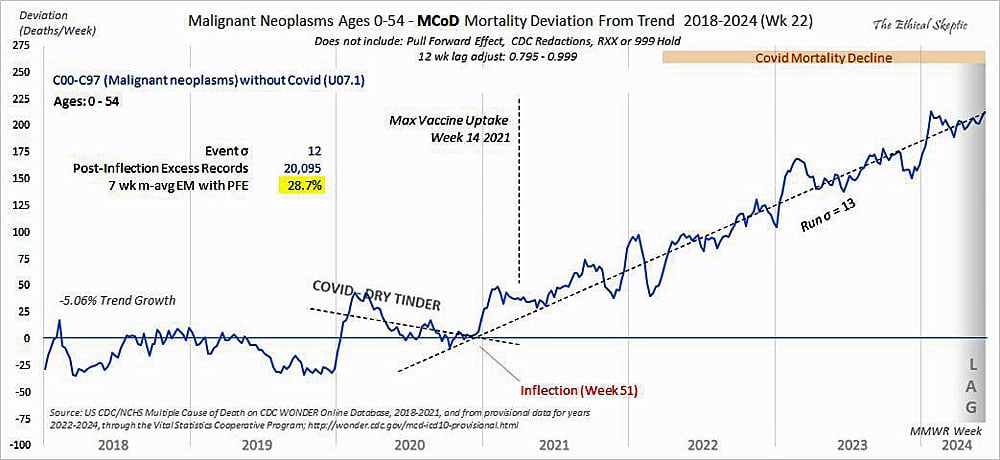
SV stands for Simian Virus, a virus that infects monkeys.Viruses are adept at co-opting our cells metabolism, redirecting the native abilities of the cell to ends that benefit only the virus.One of the tricks that SV40 uses is called a promoter.
Promoters turn genes on, so they become active.Background:(Almost) every cell in our body has the same genes.But different cells need different genes at different times.So DNA is modified with a hundred different kinds of bells and whistles that, together, assure that the needed genes are active and the rest are silent at any given time and place.In laboratory experiments, scientists frequently want to turn on a particular gene for the purpose of learning about it.
One of the standard tools that theyve learned to use is a promoter derived from the SV40 virus.It is a particularly potent way to make sure that a particular gene turns on and stays on.They can insert the SV40 promoter into DNA next to the gene that they want to study, and the gene is reliably active, overriding a lot of other cell signals that might want to suppress expression of that gene.SV40 promoters are also useful in manufacturing processes.
When a drug company wants to make a particular sequence (DNA, RNA or protein), they grow bacteria that have been genetically engineered to have the instructions for that sequence inserted into their bacterial DNA.In order to enhance productivity, the engineers will insert an SV40 promoter next to the gene that they want to be particularly active.Then this GMO bacteria becomes an efficient factory for creating just the drug that the company wants.Crash course in the Central Dogma of Molecular Biology(This is mostly true.
Exceptions have been found since Francis Crick articulated the principle in the 1950s.)Information is stored in chromosomes (DNA) in a four-letter alphabet (A,C,T,G).The shape of an A fits neatly against the shape of a T, and, similarly, a C fits snugly next to a G.So DNA exists as a double helix with every A across from a T and every C across from a G.
When DNA replicates, the helix comes unzipped and each strand is able to recreate its opposite number, when all the Ts find As, all the As find Ts, all the Cs find Gs, and all the Gs find Ts.About 2% of your DNA is genes.A gene contains instructions for making a protein.A protein is also a chain, but instead of 4 different components (nucleic acids for DNA), protein chains are made from 20 different components (amino acids for proteins).A protein has unique properties depending on the way it folds in on itself.
Each of the 20 amino acids has places where it can fit snugly against other amino acids, and typically a protein chain contains hundreds or even thousands of amino acids, and it folds reliably into its own unique shape.The DNA is in the cell nucleus, and at any given time some of the genes are open and ready to be transcribed (euchromatin), while most are locked up (heterochromatin).There are molecular decorations added to the DNA itself or to the spools (histones) around which the DNA is wound .There are also particular ways that the DNA folds a function of the other 98% of the DNA that is non-coding.
All this folding and decoration constitutes epigenetic information.Epigenetics is the process of choosing which genes are turned on and which are turned off.When a gene is turned on, the DNA opens up and an RNA chain is created next to it.The process is similar but not identical to the pairing A-T and C-G by which the DNA copies itself.After RNA is copied from a gene (then cut and pasted, because most genes are not contiguous) the RNA becomes a messenger that leaves the cell nucleus and goes out into the body of the cell.
The m in mRNA stands for messenger.Messenger RNA finds a protein factory, where the RNA sequence is read and translated.Every 3-letter unit (for example ATT or GCA) calls forth a specific amino acid.
The protein factory is called a ribosome, and there are millions of ribosomes in every cell.And thus, a gene made of DNA is translated into a particular protein that has 1/3 as many units as the gene had.The translation table that pairs every three-letter RNA sequence with a particular amino acid is called the genetic code.You and I and the platypus and oak tree and the mushroom all use the same translation table, the universal genetic code.Many philosophers of science have waxed eloquent over this discovery all life on earth is related.mRNA vaccinesThe way a traditional vaccine works is by offering your body an inactivated virus or maybe just a protein characteristic of that virus.
Your immune system identifies the protein as not belonging, and attacks it.Subsequently there is a memory, so that if youre later infected by that same virus, the immune system is primed to attack the invading protein that it remembers from the vaccine experience.The way an mRNA vaccine works is different.Instead of putting the virus into your arm, instead of putting a protein from the virus into your arm, the vaccine rather includes mRNA instructions for making one of the viruss proteins.
The mRNA has to get into one of your bodys cells, where it finds a ribosome and makes that protein.Your immune system then detects that the cell is making a foreign protein and it kills the cell.Four years ago, when Pfizer and Moderna had completed their clinical trials for mRNA vaccines and wanted to quickly ramp up production, they set up manufacturing processes with bacteria engineered to produce the RNA they needed.Bacteria were engineered with the DNA sequence corresponding to the RNA sequence that would, in turn, make the spike protein from the virus inside your body.The bacteria are grown in a factory bioreactor, and then the bacteria are processed to isolate and purify just the RNA, in fact, just the RNA that codes for the spike protein.
One step in the process is supposed to exclude DNA, but it is never 100% efficient, and, apparently, there were some vaccine batches in which much larger quantities of DNA got through.Last year,Kevin McKernan(formerly of the Human Genome Project and now atMedicinal Genomics) analyzed the Pfizer and Moderna vaccine samples and first reported that the DNA removal had not been completely effective.Remnants of the DNA used in manufacture were contaminating the vaccines at concerning levels, including the highly toxic SV40 promoter DNA.Floridas State Surgeon General, Joseph Ladapo, raised concerns about DNA contaminants in mRNA vaccines in aletter to the FDA and CDCin December, 2023.AsMcKernan and Weinstein point out, the substitution of a new manufacturing processafterthe product was safety-tested was highly irregular and, arguably, fraudulent.
Biology is complicated and a different manufacturing process means its a different drug.There were no DNA residues in the tested version of the vaccines, because they were manufactured using an entirely different process, suitable for the smaller-scale operation.McKernan tells us that when Pfizer disclosed their analysis of the manufactured vaccines to FDA, they listed some of the DNA traces, but omitted to mention the SV40 promoter.
McKernan thinks this was deliberate.Normally, our bodies very efficiently destroy DNA that is in the wrong place.Of course, the food we eat includes the DNA from the plant or animal, and it is routinely de-natured in our stomachs and also by enzymes in our blood.Foreign DNA is a problem that our bodies are well-equipped to deal with.But the mRNA vaccines are designed to evade these degrading enzymes.
Their particular technology is only able to work if the mRNA can make its way out of the bloodstream and into the bodys cells.So, by design, the mRNA in the vaccines is encased in a tiny globule of protective fat, called a lipid nanoparticle, or LNP.LNP technology not only protects the mRNA from our bodys systems that want to degrade it; the LNP also helps the RNA to slip through cell membranes so it can do the job it was designed to do.Foreign DNA is normally not a danger to our bodies.
But if it is enclosed in a LNP, then it goes right through the cell membrane.Maybe it goes right through the nuclear membrane, too this has been debated vigorously.The powerful promoters from the SV40 DNA are a particular problem.If they get into the cell nucleus, they cause their payload to insert into our native DNA with unpredictable results.
Whatever gene they are next to becomes hyperactive.It is turned on all the time, whether the cell needs it or not.The cell can become deranged and do things it was not supposed to do.CancermRNA vaccines were a new technology in 2020.
They work in a rather different way from other vaccines.Though they have been branded as vaccines for public relations, they actually fit the definition of gene therapy, and should have been regulated as such.Regulation of gene therapies is far more stringent than regulation of vaccines.There is evidence from diverse sources that cancer rates are up, starting late 2021 and continuing through the present.
State agencies that normally publish cancer data with a one-year delay are now two years behind in publishing 2022 data.Nationally, CDC also has not yet released 2022 cancer statistics.But innovative researchers are gathering statistics in other ways.
TheEthical Skeptichas tracked hospital data and plugged it into his own model to estimate current cancer diagnoses.Ed Dowd tells usthat sales of cancer drugs are up, and all-cause mortality is up.Perhaps you know people who have been diagnosed with cancer in the last two years.Some of these cancers develop and spread faster than cancers usually progress turbo cancers.
Some rare cancers have become more common.Figure by the Ethical Skeptic, based on his own analysis.</small?Today, Australia is holding hearings in which scientists are testifying about their governments response to the COVID pandemic, which was in lockstep with most other countries of the world.The testimony ofDr McKernan tells the storyof increased cancer rates, and raises the question whether this can be attributed to the SV40 promoter being inserted willy-nilly into cellular DNA, turning on genes wherever it happens to insert.HistoryIn the 1950s, the first polio vaccines were developed using cells derived from monkey kidneys.Some of these vaccines were later discovered to be contaminated with SV40.
This has been a scandal and a cover-up over the intervening decades.[ref]It is not disputed that SV40 is a potent carcinogenin vitroand in lab animals [ref].There is direct and indirect evidence that SV40 causes cancer in humans [review article].
There also has been a great deal of denial and cover-up [review article] [CDC assurances].SV40 was weaponized by American (and, presumably, foreign) military researchers.Jack Kruse claimsthat it was used in assassination attempts on Fidel Castro, and that Jack Ruby was murdered with SV40.Whether or not SV40 is a reliable enough carcinogen to be used in CIA assassinations is something we are not permitted to know.But the fact that the SV40 promoter poses dangers when it is a contaminant in widely-distributed vaccine products is a topic that urgently demands research.The fact that no government agency (and certainly no biotech company) is interested in this research is a legitimate source for suspicion.TheSorcerers Apprenticeis a 200-year-old morality tale about the boy who learned just enough about a magical technology to turn it on, but didnt understand enough to use it safely.Discover more from Josh MitteldorfSubscribe to get the latest posts sent to your email.Type your emailSubscribe
Disclaimer: This story is auto-aggregated by a computer program and has not been created or edited by Senior Savings Deals.
Publisher: Josh Mitteldorf ( Read More )
Publisher: Josh Mitteldorf ( Read More )

